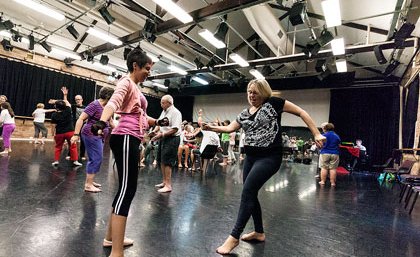
For Parkinson’s disease sufferers, it could be an ability to dance The Nutcracker that delivers another lease on life.
Physiotherapy researchers at The University of Queensland have partnered with the Queensland Ballet and the Queensland University of Technology to demonstrate the benefits of a Dance for Parkinson’s program.
Professor Sandy Brauer from UQ’s School of Health and Rehabilitation Sciences said participants’ walking speed, stability, posture and reach all improved during and after 30 ballet classes.
“We were quite surprised by the changes to some people, particularly a few of the older men who really took to it and ended up bringing a lot of enthusiasm,” Professor Brauer said.
“A key finding was the improvement in participants’ ability to walk and perform another function at the same time, which is often difficult for people with Parkinson’s disease.
“Falls are a major threat to the 80,000 Australians with Parkinson’s disease, leading to injuries, dependency and institutionalisation, so it’s a promising step towards reducing that factor.”
From a pool of 60 participants, 11 volunteers with Parkinson’s disease were closely monitored over a nine-month period.
As well as the physical benefits, the participants reported increases in confidence, focus, body awareness and emotional wellbeing.
Queensland Ballet CEO Anna Marsden said dancing led to a more positive perception of overall quality of life and provided a gateway to further physical, artistic and social activities for program participants.
“This research demonstrates more widely the positive impact that arts can have on health,” Ms Marsden said.
“Queensland Ballet is committed to continuing our Dance for Parkinson’s program, and we continue to seek further funding to sustain, develop and expand the program.”
Through music and choreography, the classes introduced participants to five ballets in Queensland Ballet’s repertoire – The Nutcracker, Coppélia, Romeo & Juliet, Serenade and Bolero.
The Dance for Parkinson’s Disease movement started in New York in 2001, but the work of UQ and QUT investigating Queensland Ballet’s program will provide the most detailed quantitative data yet on the benefits of ballet.
The next round of classes will be held on Saturdays from February 21 to April 18, from 1.30pm-2.45pm at the Thomas Dixon Centre, corner Drake St and Montague St, West End in Brisbane.
Media: Professor Sandy Brauer +617 3365 2317, s.brauer@uq.edu.au; Robert Burgin at UQ Communications, +617 3346 3035, + 61 0448 410 364, r.burgin@uq.edu.au.
.jpg)









